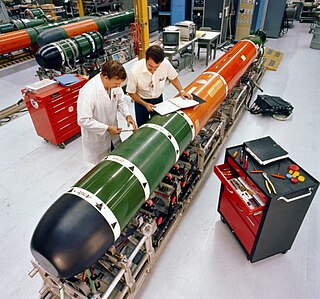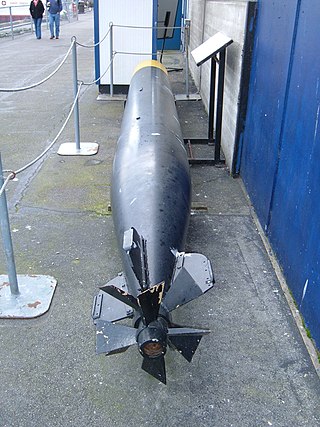Related Research Articles

A modern torpedo is an underwater ranged weapon launched above or below the water surface, self-propelled towards a target, and with an explosive warhead designed to detonate either on contact with or in proximity to the target. Historically, such a device was called an automotive, automobile, locomotive, or fish torpedo; colloquially a fish. The term torpedo originally applied to a variety of devices, most of which would today be called mines. From about 1900, torpedo has been used strictly to designate a self-propelled underwater explosive device.

The Mark 48 and its improved Advanced Capability (ADCAP) variant are American heavyweight submarine-launched torpedoes. They were designed to sink deep-diving nuclear-powered submarines and high-performance surface ships.

The United States' S-class submarines, often simply called S-boats, were the first class of submarines with a significant number built to United States Navy designs. They made up the bulk of the USN submarine service in the interwar years and could be found in every theater of operations. While not considered fleet submarines, they were the first submarines in the USN designed for open ocean, blue water operations. All previous submarines had been intended for harbor or coastal defense. These boats were intended to have greater speed and range than previous classes, with improved habitability and greater armament.

The Mark 54 lightweight torpedo is a standard 12.75-inch (324 mm) anti-submarine warfare (ASW) torpedo used by the United States Navy.

The Mark 44 torpedo is a now-obsolete air-launched and ship-launched lightweight torpedo manufactured in the United States, and under licence in Canada, France, Italy, Japan and the United Kingdom, with 10,500 being produced for U.S. service. It was superseded by the Mark 46 torpedo, beginning in the late 1960s. The Royal Australian Navy, however, continued to use it alongside its successor for a number of years, because the Mark 44 was thought to have superior performance in certain shallow-water conditions.

The Mark 24 mine is an air-dropped anti-submarine (ASW) acoustic torpedo developed by the United States during World War II; it was called a mine to conceal its capabilities. The torpedo entered service with the Allies in March 1943; the United States Navy (USN) used it until 1948. Approximately 4,000 were produced. Of the 340 deployed during the war, 204 were fired, sinking 37 and damaging 18 Axis submarines.

The Mark 37 torpedo is a torpedo with electrical propulsion, developed for the US Navy after World War II. It entered service with the US Navy in the early 1950s, with over 3,300 produced. It was phased out of service with the US Navy during the 1970s, and the stockpiles were sold to foreign navies.

The Asashio-class submarine is a submarine class of Japanese Maritime Self-Defense Force comprising four boats. This class is the successor of Ōshio. The class were the first fleet submarines constructed for post-war Japan. The first submarine was authorized as part of the 1963 shipbuilding programme. Their design improved on previous Japanese classes by being larger to obtain better seaworthiness with greater torpedo stowage. The class entered service in the late 1960s and remained as such until the mid-1980s when they were taken out of service.

The Mark 14 torpedo was the United States Navy's standard submarine-launched anti-ship torpedo of World War II. This weapon was plagued with many problems which crippled its performance early in the war. It was supplemented by the Mark 18 electric torpedo in the last two years of the war. From December 1941 to November 1943 the Mark 14 and the destroyer-launched Mark 15 torpedo had numerous technical problems that took almost two years to fix. After the fixes, the Mark 14 played a major role in the devastating blow U.S. Navy submarines dealt to the Japanese naval and merchant marine forces during the Pacific War.

The Mark 18 torpedo was an electric torpedo used by the United States Navy during World War II. The Mark 18 was the first electric storage battery torpedo manufactured for the US Navy and it was designed primarily for use as a submarine-launched torpedo.
There have been a number of 18-inch (45cm) torpedoes in service with the Royal Navy of the United Kingdom.
The Mark 19 torpedo was an electric torpedo designed in 1942 by Westinghouse Electric as a follow-on development of the Mark 18 torpedo. The goal was to build a torpedo that incorporated all-electric controls in place of pneumatic controls. Its gyroscope and depth control were electrically controlled and operated, while the rudders were solenoid operated.
The Mark 20 torpedo was a US torpedo designed in 1943 but never used in service.
The Mark 21 torpedo, designated Mark 21 Mod 0 was a passive acoustic homing torpedo designed in 1943 by Westinghouse Electric Corporation. The Mark 21 successfully passed launching tests in 1943, however, due to difficulties encountered by Westinghouse, the project was abandoned after a few development models had been built.
The Mark 22 torpedo, was an active acoustic homing torpedo developed by Bell Telephone Laboratories and Westinghouse Electric 1944. Development of this torpedo was discontinued at the end of World War II.
The Mark 28 torpedo was a submarine-launched, acoustic homing torpedo designed by Westinghouse Electric in 1944 for the United States Navy. The torpedo used all-electric controls. Service use of the Mark 28 ended after the introduction of the Mark 37 torpedo.
The Mark 29 torpedo was a submarine-launched, acoustic torpedo designed by Westinghouse Electric in 1945 for the United States Navy. It used the same acoustic system as the Mark 28 torpedo but was faster, operated at various depths, had an external depth setter, and could run as either a straight or a homing torpedo. The Mod 1 variant had two speeds, a remote-setting variable enabler and an anti-circular run device.
The Mark 31 torpedo was a destroyer-launched acoustic torpedo developed by the Harvard and Pennsylvania State universities during World War II. A modification of the Mark 18 electric torpedo, it was conceived as an interim weapon to be used in the Pacific War until a new high-speed acoustic torpedo could be developed for the United States Navy.
The Mark 36 torpedo was a submarine-launched Anti-surface ship torpedo designed by General Electric and the Naval Torpedo Station in 1946. Further development of the Mark 36 was discontinued due to the development of the Mark 42 torpedo.